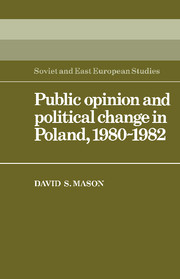Book contents
- Frontmatter
- Contents
- List of tables
- Preface
- Introduction: public opinion and politics
- 1 Public opinion research in Poland
- 2 The public and policy change in the 1970s
- 3 Values of Polish society on the eve of August
- 4 1980: causes and results
- 5 The rise and fall of Solidarity
- 6 The Party and ‘renewal’
- 7 Solidarity and the regime at the end of 1981
- 8 Martial law as a response and the response to martial law
- 9 Conclusions
- Appendix
- References
- Index
5 - The rise and fall of Solidarity
Published online by Cambridge University Press: 05 February 2012
- Frontmatter
- Contents
- List of tables
- Preface
- Introduction: public opinion and politics
- 1 Public opinion research in Poland
- 2 The public and policy change in the 1970s
- 3 Values of Polish society on the eve of August
- 4 1980: causes and results
- 5 The rise and fall of Solidarity
- 6 The Party and ‘renewal’
- 7 Solidarity and the regime at the end of 1981
- 8 Martial law as a response and the response to martial law
- 9 Conclusions
- Appendix
- References
- Index
Summary
Solidarity's membership grew phenomenally in the months following the Gdańsk agreements. By mid September, over 3 million workers from 3500 factories had joined the union or were about to. By the end of October, membership was estimated at seven million. And by the beginning of 1981, membership had peaked at 8 million or more. Most of the membership growth was in these last months of 1980. The Polacy '80 and Polacy '81 surveys conducted at the end of 1980 and the end of 1981 show roughly the same percentage of the sample professing membership in Solidarity: 36–37%. This would indicate a national membership of about 9.4 million, an astounding figure for any organization. Approximately 60% of the non-farm workforce belonged to Solidarity.
Most of the initial joiners were blue-collar workers in the major cities, but after the turn of the year, membership began to spread to all sectors of society. Intelligentsia and white-collar workers began joining in greater numbers in 1981. With the registration of ‘Rural Solidarity’ in May 1981, membership expanded in the countryside, though Solidarity was never as strong there as in the cities. Shortly thereafter, the ‘third sector’ of the economy, the craftsmen and service workers, applied for registration of their own division of Solidarity.
As indicated in Table 5.1, a majority of virtually every non-farm occupational group belonged to Solidarity. Solidarity was strongest in that part of the workforce most treasured by the regime, skilled industrial workers.
- Type
- Chapter
- Information
- Public Opinion and Political Change in Poland, 1980–1982 , pp. 105 - 137Publisher: Cambridge University PressPrint publication year: 1985



